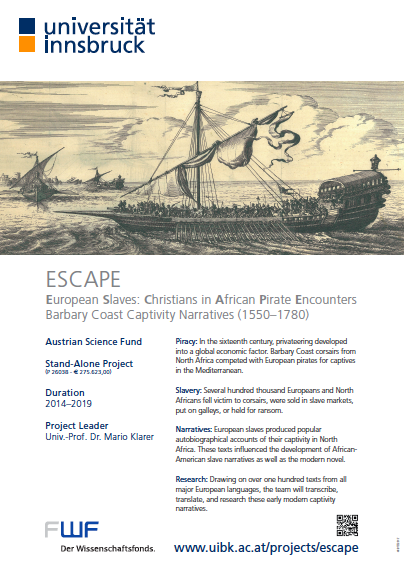Conference
Perspectives on Northern Africa in the Early Modern Period:
Piracy, Slavery, and Diplomacy
Update:
Videos from the conference:
Opening - Gillian Weiss - Khalid Bekkaoui - Joachim Östlund - Magnus Ressel - Watzka-Pauli
November 13 - 14, 2014
Claudiana (Herzog-Friedrich-Straße 3), Innsbruck
From the 16th to the early 19th century, a lively exchange took place between the Western world and the North African city-states Tripoli, Algiers, Tunis, and Salé, the so-called Barbary Coast. This exchange was cultural and economic in nature, and marked by active trading, diplomatic negotiations, and scientific exploration - but also by piracy, slavery, and religious conflict. Both friendly and hostile, these encounters on eye level between Muslims and Christians in the Mediterranean produced knowledge, images, ideas but also stereotypes and prejudices that have remain influential to this day.
Our conference concentrates on early modern portrayals of the North African population and culture by European and American sailors, traders, politicians, and diplomats in a variety of texts from this period. A special focus is put on Barbary Coast captivity narratives, that is, accounts by Westerners who were captured by Muslim pirates and enslaved in Northern Africa. These texts, written by white captives who were ransomed or managed to escape, provide a fascinating and singular first-hand perspective on the Barbary Coast and its people, and early Christian-Muslim relationships. These narratives appeared in virtually all European languages, and the multicultural composition of our conference reflects this. While the majority of talks will focus on the Western perspective, one confirmed speaker, Khalid Bekkaoui from the University of Fez, Morocco, will concentrate on Arabic sources.
If you want to participate, please email robert.spindler@uibk.ac.at by November 9.
The conference language is English.
Program (pdf):
Thursday, November 13, 2014
| 14:00-14:15 | Opening Remarks | |
| 14:15-15:15 | Gillian Weiss (Case Western Reserve University, Cleveland, Ohio): “A Huguenot Captive in ‘Uthman Dey’s Court: Histoire chronologique du royaume de Tripoly (1685) and Its Author” (link to video) |
|
| 15:30-16:30 | Carsten Junker (University of Bremen): “Benjamin Franklin: The Poetics of Abolition and the Ruses of Analogy” |
|
| 16:30-17:00 | Coffee Break | |
| 17:00-18:00 | Khalid Bekkaoui (Sidi Mohammed Ben Abdellah University, Fez): “Islamic Otherness and the Ambiguous Quest for Identity in American Barbary Captivity Narratives” (link to video) |
|
| 18:15-19:15 | Joachim Östlund (Lund University): “The Barbary Captivity Narrative and Other Stories from Northern Africa” (link to video) |
Friday, November 14, 2014
| 9:00-10:00 | Magnus Ressel (University of Frankfurt): “Algerian Captivity and World Literature. The Example of The Jew's Beech (Die Judenbuche)” (link to video) |
|
| 10:00-10:30 | Coffee Break | |
| 10:30-11:30 | Elisabeth Watzka-Pauli (University of Graz): “The Trinitarians of the Habsburg Monarchy in the 18th Century and Their ‘Redemptions’ of Slaves on the Barbary Coast” (link to video) |
Abstracts:
Khalid Bekkaoui: "Islamic Otherness and the Ambiguous Quest for Identity in American Barbary Captivity Narratives"
The paper deals with how the awareness of and encounter with the Muslim Other helped construct American national and cultural identity in the Early Republic through a complex and ambivalent narrative myth-making. This identity is expressed historically in the engagement between America and Barbary, and discursively in factual (Riley and Paddock) and fictional female (Velnet, Martin, Bradley and Laranda) captivity narratives. The paper argues that the narrativization of American national identity entailed a renegotiation and refashioning of the borders of Selfhood and Otherness as well as a recharting and negotiation of the boundaries of civilization and barbarism, whiteness and blackness.
Carsten Junker: "Benjamin Franklin: the Poetics of Abolition and the Ruses of Analogy"
In 1790, Benjamin Franklin wrote an attack on slavery titled “Sidi Mehemet Ibrahim on the Slave Trade.” In this late-eighteenth-century instance of abolitionist intervention, Franklin speaks in a satirical mode through the voice of an Algerian beneficiary of the slave trade. I will place this abolitionist intervention in the framework of its historical context and discuss it as a text-based phenomenon in particular, considering the narrative strategies that Franklin uses to ridicule contemporary slave-trade proponents in the early United States. I suggest that Franklin’s text—as it displaces debates over enslavement from an (inner-)North American scene onto one between Europeans and North Africans—serves as a particularly useful example for a discussion of the ways in which analogies were drawn between different forms of enslavement during the late eighteenth century. I intend to also discuss the text as an example that shows the limitations of such analogizing.
Joachim Östlund: “The Barbary Captivity Narrative and other Stories from Northern Africa”
For individuals who managed to return to their home countries after captivity in Northern Africa the possibilities to publish their stories was a very rare opportunity. Instead the large majority of stories of captivity and enslavement were communicated on other forms. Therefore one must take into consideration what sources and whose stories we use when we retell the story of captivity in Northern Africa. The focus of this paper is the captivity of the sailors from the Swedish ship Mercurius taken by corsairs from Morocco 1754. After two years of captivity the captain of the ship, Marcus Berg, made it back home to Sweden. 1757 his book of his life in captivity was published in Stockholm. By comparing Bergs narrative (presented as a travelogue) with stories of his crewmembers and other contemporary versions in novels and academic research it is possible to discuss how the representation of Barbary captivity was shaped in relation to different text forms and genres, individual experiences and of the cultural and political context were these stories were produced. This paper argues that it is important for historians to also take the unpublished stories, or stories without the moment of homecoming in the travelogue, into consideration.
Magnus Ressel: "Algerian captivity and World Literature. The example of The Jew's Beech (Die Judenbuche)"
The Jew’s Beech of Annette von Droste-Hülshoff (1842) can certainly be counted among the most prominent German titles within the canon of world literature. It has always attracted substantial interest from scholars in the field of German language and literary studies. Rather underrepresented in the majority of these analyses, however, has been the fact that the core of the book is based on true events of Algerian captivity of a young murderer of the area of Münster/Paderborn, who had fled the region in the 1780s and who had returned around 1806 as a broken man. In my paper, I want to highlight the “true” events as far as it is possible for a historian, thereby contextualizing the book in its time. The second part shall concentrate on the merging of fact and fiction undertaken by Droste-Hülshoff and it shall be hypothesized, which reasons stood behind each of the important changes. In the conclusion I will try to explain the success of the book which had always stood in some contrast to the rather dry style of the text. This can only be understood by highlighting “Algiers” and the captivity there in the strongly religiously influenced mentality and psychology of the German and, at least in aspects, European culture of the time.
Elisabeth Watzka-Pauli: The Trinitarians of the Habsburg Monarchy in the 18th century and their “redemptions“ of slaves in the Barbary coast
The Trinitarian order, respectively the branch of the “Spanish Discalced Trinitarians”, was established in the Habsburg Monarchy in 1688, five years after the failed Ottoman siege of Vienna and within a period of long-lasting war between the Habsburg and the Ottoman Empire. Thus, the main aim of the Austrian Trinitarians was the liberation of enslaved Christians by purchasing them from their owners in the Ottoman Empire itself, mostly in Constantinople. But after the peace of Belgrade in 1739, that ended a time of perpetual armed conflict between the Habsburg and the Ottoman Empire, the need of liberating persons from the latter diminished, and the attention for possible activities in other regions, where Christians were held captive by Non-Christians, grew quickly. Regarding the fact that the Spanish Discalced Trinitarian Order as a whole was certainly the releasing organisation most strongly represented in the Barbary States, particularly in Algiers, it was only near at hand for the Austrian province of the order, to initiate redemption undertakings there, too.
There exist so called „catalogues“ of the released persons, that have been published after each redemption enterprise by the order. Within these remarkable sources, the reader usually finds for every liberated Christian his or her name (and thus, gender, too), age, regional origin, duration of slavery, former social rank and the amount of ransom paid for him, moreover, the spender of the money for this particular redemption is noted frequently. Based upon this information and using statistical methods one can draw a quite precise sketch of “typical” Barbary coast slaves, freed by the Austrian part of the Trinitarian order.
Gillian Weiss: "A Huguenot Captive in ‘Uthman Dey’s Court: Histoire chronologique du royaume de Tripoly (1685) and Its Author"
The unsigned, two-volume, eleven-hundred-page manuscript was completed in 1685. Since Histoire chronologique du royaume de Tripoly entered the collection of France’s national library, it has drawn the greatest interest from historians interested in its account of the Borno sultanate of southern Nigeria and from archeologists interested in its descriptions of Leptis Magna and additional sites of classical antiquity. These scholars and others note that the anonymous author made his political observations and visited the Roman ruins while a captive in the Ottoman regency of Tripoli. All of them repeat biographical details from the text and from the writings of a French doctor that identify a ship surgeon from Provence employed on a Marseille corsair who spent 1668-1675 as the personal physician to the Tripolitan dey and later treated soldiers in King Louis XIV’s Swiss Guard. On the basis of new archival research, this paper will offer evidence Pierre Girard was, in fact, a Huguenot – with good reason not to attach his name to an account completed the year of the Revocation of the Edict of Nantes. As such, Histoire chronologique du royaume de Tripoly, stands as one of the only North African captivity narratives by a French Protestant, a man who seems to have traded physical constraint and religious freedom in Libya for physical freedom and religious dissimulation in France.



